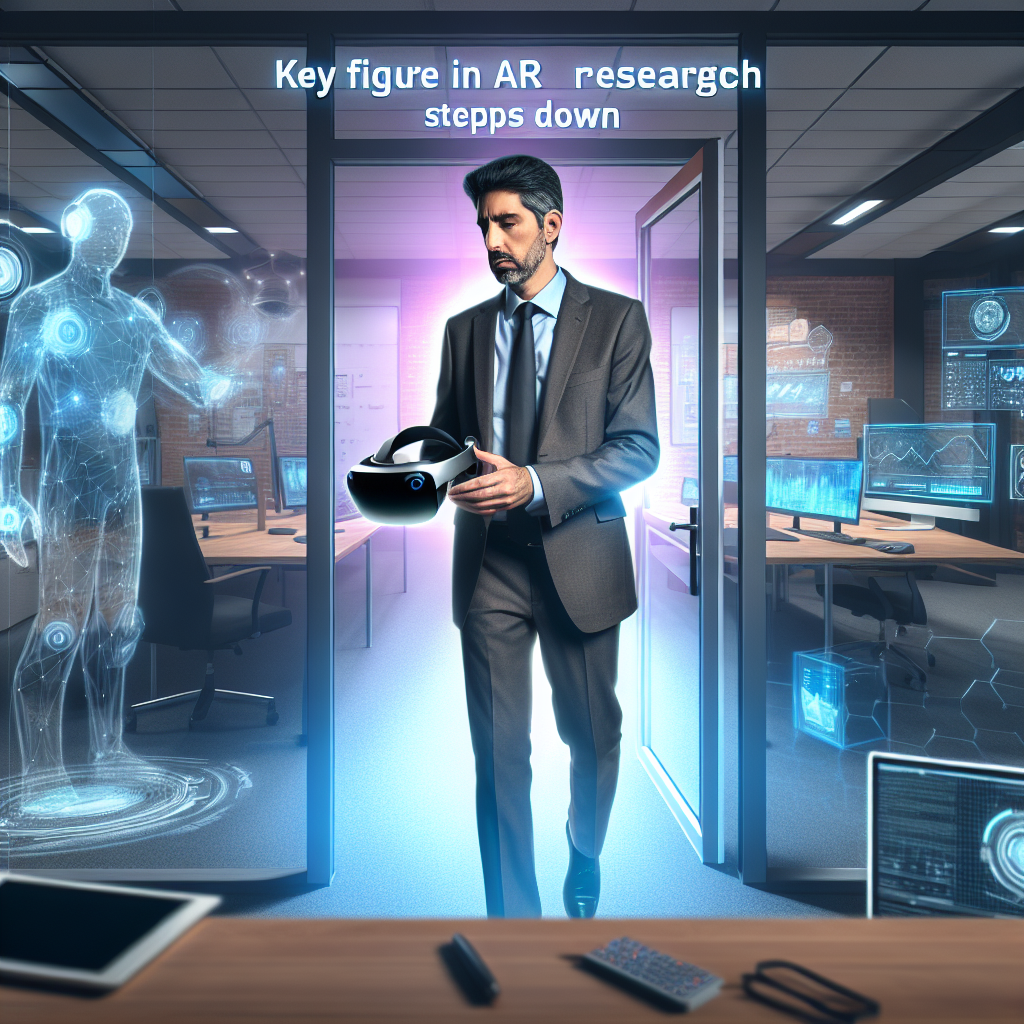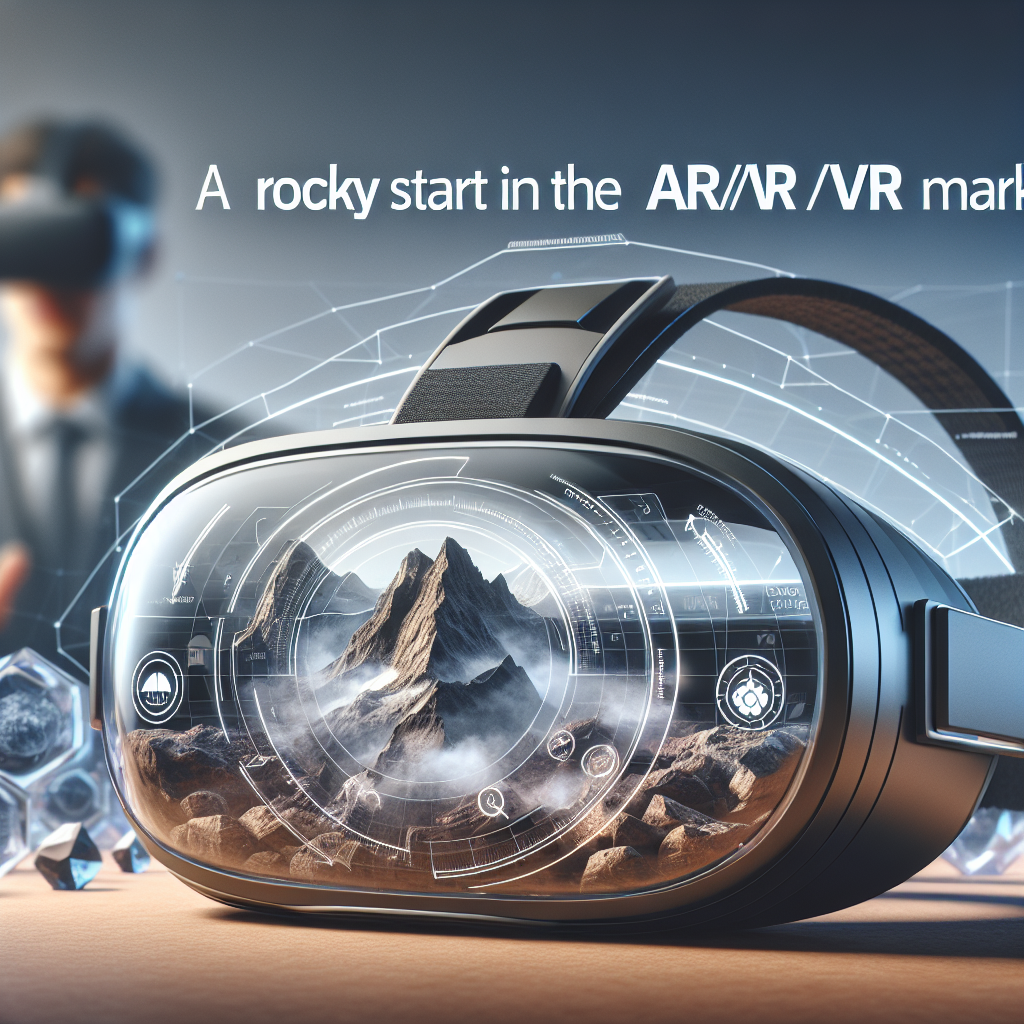Unveiling the Vanishing Act: Google’s AR Search Takes a Mysterious Turn
Imagine being able to search for information and see it appear right in front of you, as if it were part of the real world. This is the promise of augmented reality (AR) search, a technology that has been gaining traction in recent years. One of the biggest players in this field is Google, with its AR search feature that allows users to explore and interact with digital content in their physical surroundings. However, in a surprising turn of events, Google seems to have made its AR search disappear. Users are reporting that the feature is no longer available, leaving them wondering what happened and what the future holds for AR search.
In this article, we will delve into the mysterious disappearance of Google’s AR search and explore the implications it has for the future of augmented reality. We will examine the rise of AR search and how Google became a frontrunner in this space. We will also look at the possible reasons behind the removal of the feature and the impact it has on users who have come to rely on it. Additionally, we will discuss the broader implications for the AR industry and what this means for the advancement of AR technology as a whole. Join us as we unravel the disappearing act of Google’s AR search and uncover the truth behind its sudden vanishing.
Key Takeaway 1: Google’s AR search feature is being phased out
Google’s augmented reality (AR) search feature, which allowed users to view 3D models of various objects in their physical environment, is slowly disappearing. This move comes as Google shifts its focus towards other AR initiatives and prioritizes different aspects of its search functionality.
Key Takeaway 2: Lack of user engagement and practicality
One of the reasons behind the disappearing act of Google’s AR search is the lack of user engagement and practicality. While the feature initially garnered attention and excitement, it failed to become an integral part of users’ search experience due to limited use cases and challenges in implementation.
Key Takeaway 3: Shifting focus to AR in e-commerce
Google is redirecting its efforts towards using AR technology in the e-commerce sector. By enabling users to visualize products in their own space before making a purchase, Google aims to enhance the online shopping experience. This strategic shift aligns with the growing trend of virtual try-on and augmented reality shopping.
Key Takeaway 4: Integration with Google Lens
While the standalone AR search feature is disappearing, elements of it will be integrated into Google Lens. Google Lens, an image recognition tool, will incorporate AR capabilities to provide users with more contextual information about objects they scan. This integration aims to offer a more seamless and intuitive search experience.
Key Takeaway 5: Future possibilities for AR in search
Although Google’s AR search feature may be fading away, the potential for AR in search remains promising. As technology continues to advance and user demands evolve, we can expect to see new and innovative applications of AR in search, transforming the way we interact with information and our surroundings.
Trend 1: Integration with Smart Glasses
One emerging trend in the world of augmented reality (AR) search is the integration of AR technology with smart glasses. Google is at the forefront of this trend with its development of Google Glass, a wearable device that overlays digital information onto the user’s field of view. With the disappearance of traditional search interfaces like smartphones and computers, users can now simply look at an object or location and receive relevant information in real-time.
This integration of AR search with smart glasses has the potential to revolutionize the way we interact with the world around us. Imagine walking down the street and being able to instantly access information about nearby restaurants, historical landmarks, or even the nutritional value of the food in your grocery cart. With the disappearance of traditional search interfaces, this technology has the potential to seamlessly integrate into our daily lives, providing us with a wealth of information at our fingertips.
Trend 2: Enhanced Visual Search
Another emerging trend in the world of AR search is the development of enhanced visual search capabilities. Traditional text-based search queries are being replaced by visual inputs, allowing users to simply point their device at an object or image to retrieve relevant information. This technology is particularly useful in situations where language barriers or limited knowledge of a subject may hinder traditional search methods.
Google’s AR search technology is able to recognize objects, landmarks, and even artwork, providing users with detailed information about what they are looking at. For example, if you come across a famous painting in a museum but don’t know its name or artist, you can simply point your device at it and receive instant information about its history and significance. This enhanced visual search capability has the potential to make learning about the world around us more accessible and engaging.
Trend 3: Integration with E-commerce
A third emerging trend in AR search is the integration of this technology with e-commerce platforms. As more and more people turn to online shopping, the ability to see and interact with products before making a purchase becomes increasingly important. Google’s AR search technology allows users to visualize products in their own environment, providing a more immersive and realistic shopping experience.
Imagine being able to try on virtual clothing or place furniture in your living room to see how it would look before making a purchase. With the disappearance of traditional search interfaces, users can now browse and interact with products in a more intuitive and personalized way. This integration of AR search with e-commerce has the potential to increase customer satisfaction and reduce the number of returns, as users have a better understanding of what they are buying.
Future Implications
The disappearing act of Google’s AR search has significant future implications. As the technology continues to evolve and become more integrated into our daily lives, we can expect to see a number of changes in various industries.
In the field of education, AR search has the potential to transform the way students learn. Instead of relying solely on textbooks and lectures, students can use AR technology to explore and interact with subjects in a more immersive and engaging way. This hands-on approach to learning has been shown to improve retention and understanding of complex concepts.
In the healthcare industry, AR search could revolutionize the way doctors diagnose and treat patients. By overlaying medical information onto a patient’s body, doctors can quickly access relevant data and make more informed decisions. This technology has the potential to improve patient outcomes and reduce medical errors.
Additionally, the integration of AR search with e-commerce platforms has the potential to disrupt the retail industry. Traditional brick-and-mortar stores may need to adapt to the changing landscape by incorporating AR technology into their shopping experiences. This could involve creating virtual showrooms or offering personalized product recommendations based on a user’s preferences and previous purchases.
Overall, the disappearing act of Google’s AR search opens up a world of possibilities. From enhanced visual search capabilities to integration with smart glasses and e-commerce platforms, this technology has the potential to revolutionize the way we interact with information and the world around us. As the technology continues to advance, we can expect to see even more exciting developments and applications in the future.The Controversial Aspects of Google’s AR Search
1. Privacy Concerns
One of the most significant controversies surrounding Google’s AR Search is the potential invasion of privacy. With AR technology, Google has the ability to overlay digital information onto the real world, including people’s homes, workplaces, and public spaces. This raises concerns about the collection and use of personal data without consent.
Privacy advocates argue that Google’s AR Search could lead to a new level of surveillance, as the technology allows for the constant monitoring and recording of individuals’ activities. There are concerns that Google could use the data collected through AR Search to build detailed profiles of users, which could be used for targeted advertising or even sold to third parties.
On the other hand, proponents of Google’s AR Search argue that the company has a strong track record of protecting user privacy. They highlight Google’s efforts to provide transparency and control over data collection through features like privacy settings and user consent prompts. They argue that as long as users are aware of the data being collected and have the ability to opt-out, the privacy concerns can be adequately addressed.
2. Ethical implications
Another controversial aspect of Google’s AR Search is the ethical implications of overlaying digital content onto the real world. Critics argue that this technology blurs the line between the virtual and physical realms, potentially leading to a loss of authenticity and the erosion of shared public spaces.
There are concerns that AR Search could be used to manipulate or distort reality, as digital content can be easily created and manipulated. This raises questions about the reliability of the information presented through AR Search and the potential for misinformation or propaganda to be spread through the technology.
Proponents of Google’s AR Search argue that it has the potential to enhance our understanding of the world and provide valuable information in real-time. They believe that with proper regulation and content moderation, the ethical concerns can be mitigated. They point to the positive applications of AR technology, such as educational experiences and immersive storytelling, as evidence of its potential benefits.
3. Impact on physical experiences
Google’s AR Search has the potential to change the way we interact with the physical world. While this can be seen as a positive development, there are concerns about the impact it may have on our physical experiences and the loss of real-world engagement.
Some argue that relying on AR Search for information may lead to a decrease in critical thinking and personal exploration. Instead of actively engaging with our surroundings and seeking out information, users may become dependent on the digital overlays provided by AR Search. This could lead to a loss of curiosity and a narrowing of our experiences.
On the other hand, supporters of AR Search argue that it can enhance our physical experiences by providing additional context and information. They believe that AR technology has the potential to enrich our understanding of the world and make it more accessible to everyone. They argue that it is up to individuals to strike a balance between using AR Search as a tool for information and maintaining a connection with the physical world.
A Balanced Viewpoint
While Google’s AR Search offers exciting possibilities, it also raises important concerns that need to be addressed. Privacy concerns should not be taken lightly, and it is crucial for Google to ensure transparency and control over data collection. Striking a balance between the benefits of AR Search and the potential risks is essential.
Regulation and content moderation can play a significant role in addressing ethical concerns associated with AR Search. It is important to establish guidelines to prevent the spread of misinformation and to ensure the authenticity of digital content overlaid onto the real world.
Finally, the impact on physical experiences should be carefully considered. While AR Search can enhance our understanding of the world, it is important to maintain a balance between digital and physical engagement. Encouraging users to actively explore and seek out information beyond the digital overlays can help mitigate the risk of over-reliance on AR technology.
Ultimately, Google’s AR Search has the potential to revolutionize the way we interact with information and the world around us. However, it is crucial to address the controversial aspects and find ways to mitigate the risks to ensure a responsible and beneficial integration of AR technology into our lives.
The Rise of AR Search
Augmented Reality (AR) has been a buzzword in the tech industry for quite some time now. It offers a unique way of blending the digital world with the physical world, enhancing our perception and interaction with reality. One area where AR has shown great potential is in search technology. Google, being a pioneer in the field of search, has been at the forefront of developing AR search capabilities. With the of ARCore and ARKit, Google has made significant strides in bringing AR search to the masses.
The Promise of AR Search
The promise of AR search is to provide users with a more immersive and interactive search experience. Instead of relying solely on text-based search results, AR search allows users to visualize information in their physical surroundings. For example, imagine being able to see restaurant reviews and ratings hovering above the actual restaurant as you walk down the street. This not only adds a new level of convenience but also enhances the decision-making process by providing contextual information.
Google’s AR Search Initiatives
Google has been actively working on integrating AR search into its existing products and services. One of the most notable initiatives is the integration of AR search in Google Maps. With the help of ARCore, Google Maps now allows users to navigate through the real world using AR overlays. This means that instead of following a static map, users can simply hold up their phone and see virtual arrows and directions superimposed on the real world. This makes navigation more intuitive and helps users find their way more easily.
Challenges Faced by Google
While Google has made significant progress in developing AR search capabilities, it has also faced several challenges along the way. One of the main challenges is the accuracy and reliability of AR tracking. AR relies on accurately tracking the user’s position and orientation in the real world. However, this can be a complex task, especially in dynamic environments or areas with poor GPS signals. Google has been working on improving the accuracy of AR tracking, but there is still room for improvement.
Privacy Concerns
As with any new technology, there are also privacy concerns associated with AR search. Since AR search requires access to the user’s camera and location data, there is a potential for misuse or unauthorized access to personal information. Google has taken steps to address these concerns by implementing strict privacy policies and giving users control over their data. However, it is important for users to be aware of the potential privacy risks and take necessary precautions when using AR search.
Real-World Applications
Despite the challenges and concerns, AR search has already found practical applications in various industries. For instance, in the retail sector, AR search allows customers to try on virtual clothes or see how furniture would look in their homes before making a purchase. In the education sector, AR search can enhance learning by providing interactive visualizations and simulations. These real-world applications demonstrate the potential of AR search to revolutionize the way we interact with information.
The Future of AR Search
Looking ahead, the future of AR search seems promising. As technology continues to advance, we can expect more accurate and seamless AR experiences. Google, along with other tech giants, is investing heavily in AR research and development. With the growing popularity of wearable devices like smart glasses, AR search could become even more integrated into our daily lives. The possibilities are endless, and it is only a matter of time before AR search becomes a mainstream technology.
Google’s AR search initiatives have shown great potential in enhancing the way we search for information. The integration of AR into products like Google Maps has already made navigation more intuitive and convenient. However, there are still challenges to overcome, such as improving AR tracking accuracy and addressing privacy concerns. Despite these challenges, the real-world applications of AR search are already being realized in various industries. As technology continues to advance, we can expect AR search to become more integrated into our daily lives, transforming the way we interact with information.Case Study 1: IKEA Place
One of the most successful applications of Google’s AR Search was seen in IKEA Place, an app developed by the Swedish furniture giant. With the help of Google’s AR technology, IKEA Place allows users to virtually place furniture and home decor items in their own space, giving them a realistic preview of how the products would look in their homes.
By leveraging Google’s AR Search, IKEA Place has revolutionized the way people shop for furniture. Instead of relying on measurements and imagination, customers can now use their smartphones to see how a specific piece of furniture would fit into their existing decor. This has significantly reduced the chances of purchasing the wrong size or style, leading to a decrease in returns and increased customer satisfaction.
Case Study 2: Snapchat’s AR Lenses
Snapchat, the popular social media platform, has also harnessed the power of Google’s AR Search to create engaging and interactive experiences for its users. One notable example is Snapchat’s AR Lenses, which allow users to transform their faces into various characters or add virtual elements to their surroundings.
By integrating Google’s AR Search, Snapchat has been able to enhance the realism and accuracy of its AR Lenses. Users can now seamlessly overlay virtual objects onto their environment, creating captivating and shareable content. Whether it’s adding a dancing hot dog to a real-life scene or turning oneself into a cute animal, Snapchat’s AR Lenses have become a viral sensation, attracting millions of users worldwide.
Case Study 3: Google Maps Live View
Google Maps Live View is another successful implementation of Google’s AR Search. This feature allows users to navigate their surroundings using augmented reality, with virtual arrows and directions overlaid onto the real world through their smartphone’s camera.
By leveraging Google’s AR technology, Google Maps Live View provides users with a more intuitive and immersive navigation experience. Whether it’s exploring a new city or finding a specific address, users can simply follow the virtual arrows overlaid on the real world, making it easier to navigate complex or unfamiliar environments. This has proven to be especially useful in dense urban areas or places with intricate street layouts, where traditional map-based directions can be confusing.
FAQs
1. What is Google’s AR Search?
Google’s AR Search is a feature that allows users to view 3D augmented reality (AR) models of various objects and creatures directly from their search results. It uses the device’s camera to overlay the virtual object onto the real world, giving users an interactive and immersive experience.
2. Why is Google’s AR Search disappearing?
Google’s AR Search is not disappearing completely. However, it may not be available for all devices or in all regions. The availability of AR Search depends on factors like device compatibility, internet connection, and the specific object or creature being searched.
3. How can I access Google’s AR Search?
To access Google’s AR Search, simply open the Google search app on your compatible device and search for an object or creature that is supported by AR Search. If the feature is available for your device and in your region, you will see a “View in 3D” or “View in your space” option in the search results. Tap on it to experience the AR model.
4. Which devices support Google’s AR Search?
Google’s AR Search is supported on a wide range of devices, including Android smartphones and tablets running Android 7.0 or later, as well as iPhones and iPads running iOS 11.0 or later. However, the availability of AR Search may vary depending on the device’s hardware capabilities.
5. What objects and creatures can I view in AR using Google’s AR Search?
Google’s AR Search supports a growing number of objects and creatures that can be viewed in augmented reality. Some popular examples include animals, dinosaurs, planets, and even some household items. Google continues to add new AR models to its database, so the range of objects and creatures available is expanding over time.
6. Can I interact with the AR models in Google’s AR Search?
Yes, you can interact with the AR models in Google’s AR Search to some extent. You can rotate, zoom in, and zoom out to get a better view of the object or creature. Some models also have additional interactive features, such as animations or informational labels that provide educational insights.
7. Is Google’s AR Search only available in English?
No, Google’s AR Search is available in multiple languages. The availability of AR Search in different languages depends on Google’s localization efforts. However, it’s worth noting that the range of supported objects and creatures may vary across different languages.
8. Can I use Google’s AR Search without an internet connection?
No, Google’s AR Search requires an internet connection to download and display the AR models. Once the models are downloaded, you may be able to view them offline for a limited period of time, but the initial connection is necessary.
9. Are there any privacy concerns with Google’s AR Search?
Google’s AR Search does not pose any significant privacy concerns. The feature uses the device’s camera to overlay the AR models onto the real world, but it does not collect or store any personal data. However, it’s always a good practice to be mindful of your surroundings and respect the privacy of others when using AR Search.
10. What are some potential future developments for Google’s AR Search?
Google is continuously working on expanding and improving its AR Search feature. In the future, we can expect to see more objects and creatures added to the AR model database, as well as enhancements to the interactive capabilities of the AR models. Google may also explore collaborations with other companies or organizations to bring more diverse AR experiences to users.Common Misconceptions about
Misconception 1: Google’s AR Search has completely disappeared
One common misconception about Google’s AR Search is that it has completely disappeared. This misconception may have arisen due to the fact that Google made some changes to the way AR Search is accessed and used. However, it is important to note that AR Search is still available and accessible to users.
Previously, Google’s AR Search was integrated into the Google app, allowing users to search for 3D augmented reality objects and view them in their physical surroundings using their smartphone camera. However, Google has now moved this functionality to the Google Chrome browser.
Users can still access AR Search by performing a search on Google using their mobile device’s Chrome browser. When searching for compatible objects, users will see a “View in 3D” button, which allows them to view the object in augmented reality.
Therefore, it is incorrect to say that Google’s AR Search has disappeared. It has simply been relocated and can now be accessed through the Chrome browser instead of the Google app.
Misconception 2: Google’s AR Search is no longer supported
Another common misconception is that Google has discontinued support for AR Search. This misconception may have arisen due to the change in the way AR Search is accessed, as mentioned earlier. However, Google continues to support and improve AR Search functionality.
By moving AR Search to the Chrome browser, Google has made it more accessible to a wider range of users. Previously, AR Search was limited to users who had the Google app installed on their devices. Now, anyone with a mobile device that has the Chrome browser installed can access and use AR Search.
Google is also actively working on expanding the library of 3D objects available for AR Search. They have partnered with various organizations and brands to create 3D models of objects that can be viewed in augmented reality. This ongoing support and development of AR Search demonstrate that Google is committed to enhancing the user experience and keeping the feature relevant.
Misconception 3: AR Search is only available on certain devices
Some people believe that AR Search is only available on certain devices, such as high-end smartphones or specific brands. However, this is not true. Google’s AR Search is available on a wide range of devices, including both Android and iOS platforms.
As long as a mobile device has the Google Chrome browser installed, users can access AR Search functionality. This means that users with mid-range or budget smartphones can also enjoy the augmented reality experience offered by AR Search.
It is worth noting that the quality of the AR experience may vary depending on the device’s capabilities. High-end smartphones with advanced camera systems and powerful processors may provide a smoother and more immersive AR experience. However, AR Search is designed to be accessible to a wide range of users, regardless of their device specifications.
In conclusion, it is important to dispel these common misconceptions about Google’s AR Search. The feature has not disappeared but has been relocated to the Chrome browser, and Google continues to support and improve its functionality. AR Search is also available on a wide range of devices, making it accessible to a broader audience. As technology continues to advance, we can expect further enhancements and developments in the field of augmented reality, making AR Search an exciting feature to watch.1. Stay informed about emerging technologies
Keep yourself updated with the latest advancements in technology, especially in the field of augmented reality (AR) and search engines. Follow tech blogs, subscribe to newsletters, and join online communities to stay ahead of the game.
2. Experiment with AR search features
Take the time to explore and experiment with the AR search features that Google and other search engines offer. Try searching for various objects, animals, or landmarks to see how AR can enhance your understanding and interaction with the virtual world.
3. Use AR search for educational purposes
AR search can be a valuable tool for learning and education. Use it to explore historical sites, examine 3D models of scientific concepts, or even learn a new language by interacting with virtual objects.
4. Incorporate AR into your travel planning
When planning your next trip, use AR search to virtually explore your destination. Get a sense of the landmarks, attractions, and local culture before you even set foot there. This can help you make more informed decisions and enhance your overall travel experience.
5. Enhance your shopping experience
Next time you’re shopping online, leverage AR search to visualize how products will look in your space. Whether it’s furniture, clothing, or home decor, AR can help you make better purchasing decisions by virtually placing items in your environment.
6. Improve your DIY projects
AR search can be a useful tool for DIY enthusiasts. Need to hang a picture? Use AR to visualize the placement before making any holes. Want to see how a new paint color will look on your walls? AR search can help with that too.
7. Discover hidden gems in your city
Use AR search to uncover hidden gems and points of interest in your city. Scan your surroundings with your smartphone and let AR provide you with information about nearby attractions, historical sites, or local businesses you may have missed.
8. Engage with AR in social media
Many social media platforms now support AR features. Experiment with filters, effects, and interactive elements to enhance your posts and engage with your followers in a more immersive way.
9. Stay mindful of privacy concerns
While AR search can be exciting and useful, it’s important to be mindful of privacy concerns. Understand the data collection and usage policies of the AR search tools you use, and be cautious about sharing personal information or allowing access to your device’s camera.
10. Share your AR experiences with others
Lastly, don’t forget to share your AR experiences with friends, family, and colleagues. Whether it’s through social media posts, conversations, or even organizing AR-themed gatherings, sharing your experiences can inspire others to explore the possibilities of AR search.
In conclusion, the disappearing act of Google’s AR search has raised concerns and sparked discussions about the future of augmented reality technology. The removal of this feature from Google’s search results has left users disappointed and questioning the company’s commitment to AR development. While Google has not provided a clear explanation for the removal, speculation points to potential technical challenges or a shift in priorities towards other AR projects.
Despite the disappearance of Google’s AR search, it is evident that augmented reality technology continues to hold immense potential. From enhancing user experiences to revolutionizing industries such as retail and education, AR has the power to transform the way we interact with digital information. As other tech giants invest heavily in AR development, it remains to be seen whether Google will re-enter the AR search space or focus on other AR endeavors. Regardless, the disappearing act of Google’s AR search serves as a reminder that the path to widespread adoption of AR technology is not without its obstacles and setbacks.




